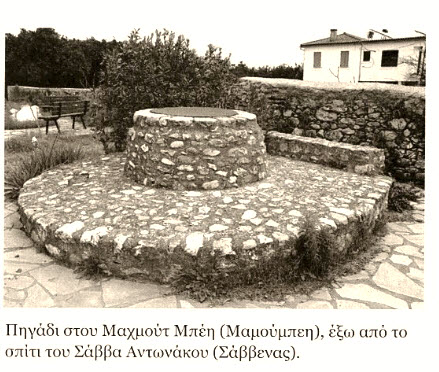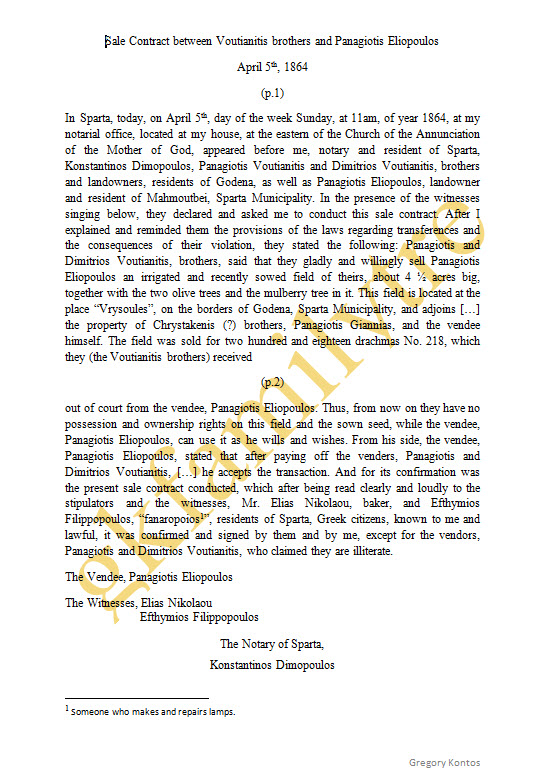This is a continuation of the previous post about Machmoutbei. These posts are excerpts from the book, Amykles, by Sarantos P. Antonakos, with translations by Giannis Michalakakos.
Thirty ordinary men successfully resisting the Egyptian army of Ibrahim Pasha? This is the stuff of action movies! And this story is true. During the Revolution of 1821 the people of Sklavochori, with support from other Laconians and Maniots, wrote a heroic but not well-known page in the history of the Revolution of 1821.
After the catastrophe of Missolonghi, Ibrahim Pasha returned to the southern Peloponnese. Humiliated after three defeats by the Maniots, Ibrahim brought in Egyptian army reinforcements and began a full assault in Laconia.

Ibrahim Pasha; Wikipedia
In 1826, his army of 25,000 men reached Mystras. He found the city abandoned as its citizens had fled, hiding in the caves and crevices of the Taygetos mountains. After looting Mystras, the army spread throughout the Evrotas valley where it did not leave “one rock upon a rock.” Ibrahim devastated the region and burned everything in his path. The villages of Sklavahori, Agios Ioannis, Magoula, Parori and Anogia faced, for the first time, sheer catastrophe.
General Panagiotis Giatrakos and his Laconian captains led their forces to battle in the villages of Perivolia, Georgitsi and other areas. But the most serious resistance against the Egyptian armies was made in the tower of Machmoutbei. Thirty people–volunteers from the region led by a priest, Panagiotis Roussos, and Captain Giannakis Theofilakos–entered the tower.They were well prepared with stores of food and ammunition, and a fierce determination to repel the Egyptian forces.
Antonakos writes:
When the first soldiers of Ibrahim Pasha reached the tower, the Greeks started a rain of fire. Even though the Egyptians used stronger aggressive attacks against the tower, Papa Roussos, the priest, showed heroic resistance and pinned them with great damages. Very dangerous for the people inside the tower was the artillery of the Egyptians, which was posted in the cliffs near the tower and was very successful against the building.
A critical moment for the Greeks was the death of their leader. On the 16th day of the siege, Papa Roussos tried to fix an opening in the tower at midnight, using a candle. At that moment, an Arab sniper hit him with success and killed him. Despite this loss, the defenders of the tower continued their resistance. After 16 days, Ibrahim saw that even his artillery was not effective against the tower. He ordered his mechanics to dig ditches in order to place explosives and blow up the tower. The defenders of the tower understood what was happening, and in order to be safe, they decided to make a heroic exodus [exit the tower]. When darkness fell around 10:00 on Day 17, they opened the doors and went down to the yard of the tower. There, they stayed until midnight. Under the leadership of Dimitris Karagkioules, a heroic fighter with seven wounds from previous battles, they took only their swords and with the help of the darkness and cover from the tower walls, they escaped. When they met Arab patrols, Karagkoulies, who knew the Arabic language, tricked them into thinking the men were Ibrahim’s soldiers.
In this way–with no casualties–they escaped from the tower. When they reached Socha Kalyvia, they shot the last patrol of the Egyptians and celebrated their freedom. Then, they moved to the mountain Taygetos and went to the camp of Panagiotis Giatrakos. Of the 30 men who were in the tower of Machmoutbei, two were missing. One was the leader, Pappa Roussos, who was shot while trying to close a gap in the wall, and the other was a man named Kokkinakis who had been seriously injured in the foot and could not follow the exodus.
The morning after the Greeks exited the tower, the Egyptian soldiers were afraid to enter. When they did, they found that the only defender left was the injured Kokkinakis. They were disappointed that General Panagiotis Giatrakos was not there. Ibraham Pasha gave orders to demolish the biggest part of the tower. The marks of this destruction were obvious and the older people in the area still remember them.
The profound significance of this event is encapsulated by one sentence of the Certificate of Aristeia [an honorary award] given to Anastasoula, the daughter of Papa Roussos: Through this siege, they [the defenders] bought time and the Christians of Lacedaimon were saved from captivity by the Arabs.
Aristeia certificates, signed by the Giatrakos brothers (all of whom were Laconian captains) were also issued to Giannakis Theofilakos and Dimitris Karagkioules.
Unfortunately, I could not find a picture of the tower of Machmoutbei. However, this photo is representative of an Ottoman tower built in the Peloponnese; circa 1808, in Monemvasia.

Tower built by Ottomans, c. 1808; Monemvasia. http://el.travelogues.gr/item.php?view=50007; sent by Giannis Michalakakos.
After the Revolution, the Tower of Machmoutbei was taken over by the Giatrakos family, and eventually purchased by Sarantos Antonakos. The tower has now been demolished and its materials were used to surround the field of St. Paraskevi. During the demolition, pieces of ancient stones with architectural designs were found embedded in the walls. It is likely that these fragments were part of the ancient sanctuary of Amykles, a site currently under archaeological excavation (see this website). For two hundred years, the Tower of Machmoutbei had stood as a mighty fortress and a symbol of strength through many battles and sieges, including those of World War II.
This is a photo of a well built in the 1800’s in Machmoutbei. It stands outside the house of Savva Antonakos (Savvenas).

Translation: Well of Machmout Bey, outside the house of Savva Antonakou (Savvelas). Source: Amykles, Yesterday and Today, published 2016 by the Women’s Syllogos of Amykles
This story of the Battle of Machmoutbei touched me deeply. It is not just general history–it is my history, as my Zarafonitis family lived there during this time. There are innumerable stories of heroism and fortitude that will never be found in formal history texts. I am grateful for authors such as Antonakos whose works bring perpetuity to their villages, and edify descendants with both knowledge and pride.
The last post in this series will explore the ministry of St. Nikon in Amykles and the villages around Sparta.
To read part one about the village of Sklavochori, click here.
To read part two about Machmoutbei, click here.
***
In 1982, Sarantos P. Antonakos published Amykles, a history book about his native village. Amykles is one of my ancestral villages, too–the birthplace of my 3rd great grandfather, Panagiotis Zarafonitis. I am beyond excited to have found this book in the Central Library of Sparta, and I copied some of the pages relevant to my family. With sincere thanks to Giannis Michalakakos for his translations and history lessons, I am learning much about this beautiful village and the lives of my ancestors. This is the third post with excerpts from the book.







